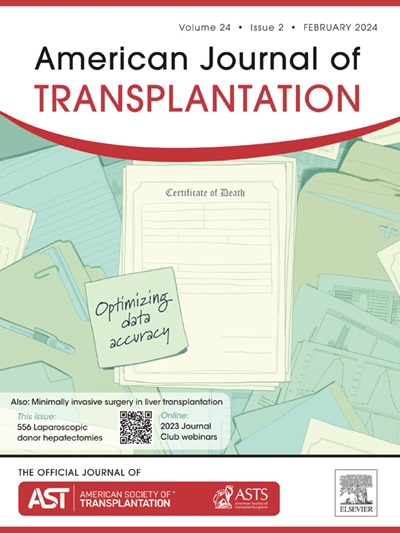Liver transplantation for hepatitis D virus/hepatitis B virus coinfection in Italy: An intention-to-treat analysis of long-term outcomes
IF 8.9
2区 医学
Q1 SURGERY
引用次数: 0
Abstract
Patients with hepatitis D virus (HDV)/hepatitis B virus (HBV)-related end-stage liver disease candidates for liver transplantation (LT) have traditionally been regarded as a special population, although their outcomes are controversial. An intention-to-treat (ITT) analysis of long-term outcomes of HDV/HBV-coinfected patients waitlisted for LT in Italy, between 2011 and 2020, was performed and compared with HBV-monoinfected LT candidates. Of 1731 HBV-infected LT candidates, 1237 (71.5%) had HBV monoinfection and 494 (28.5%) HDV/HBV coinfection. At listing, HDV/HBV-coinfected patients were significantly younger, listed mainly for decompensated cirrhosis, and with fewer hepatocellular carcinoma (HCC) cases; (26% vs 65.8%; P <.0001) compared with HBV-monoinfected patients. HDV/HBV-coinfected patients showed better 5-year ITT survival (83.2%; 95% CI: 79.4%-83.4%, vs 71.6%; 95% CI: 68.8%-74.2%; P < .0001). ITT-multivariable analysis identified the presence of HCC, advanced recipient age, and high model for end-stage liver disease-Na scores as mortality risk factors. Five years after LT, 99.1% of HDV/HBV-coinfected patients received oral nucleos(t)ide analogs, with immunoglobulins against antigen of the hepatitis B virus in 91.8% of cases. HBV and HDV viral recurrences were 1.1% and 0.2%, respectively, whereas recurrent or de novo HCC were 8.9% and 0.3%, respectively. In Italy, HDV/HBV-coinfected patients waitlisted for LT showed more favorable outcomes compared with HBV-monoinfected patients, both before and after LT. These excellent results, from the largest cohort reported so far, suggest that HDV/HBV-coinfected LT recipients do not represent a risky population and may be considered for simpler long-term antiviral prophylactic strategies.
意大利HDV/HBV合并感染的肝移植:长期结果的意向治疗分析。
肝移植(LT)的HDV/ hbv相关终末期肝病候选者传统上被认为是一个特殊的人群,尽管他们的结果存在争议。对意大利2011-2020年间等待肝移植的HDV/ hbv合并感染患者的长期结局进行了意向治疗(ITT)分析,并与单hbv感染的肝移植候选人进行了比较。在1,731例hbv感染的LT候选人中,1,237例(71.5%)为hbv单感染,494例(28.5%)为HDV/ hbv合并感染。在入选时,HDV/ hbv共感染患者明显年轻化,主要为失代偿性肝硬化,并且较少发生肝细胞癌(HCC:26% vs 65.8%,P
本文章由计算机程序翻译,如有差异,请以英文原文为准。
求助全文
约1分钟内获得全文
求助全文
来源期刊
CiteScore
18.70
自引率
4.50%
发文量
346
审稿时长
26 days
期刊介绍:
The American Journal of Transplantation is a leading journal in the field of transplantation. It serves as a forum for debate and reassessment, an agent of change, and a major platform for promoting understanding, improving results, and advancing science. Published monthly, it provides an essential resource for researchers and clinicians worldwide.
The journal publishes original articles, case reports, invited reviews, letters to the editor, critical reviews, news features, consensus documents, and guidelines over 12 issues a year. It covers all major subject areas in transplantation, including thoracic (heart, lung), abdominal (kidney, liver, pancreas, islets), tissue and stem cell transplantation, organ and tissue donation and preservation, tissue injury, repair, inflammation, and aging, histocompatibility, drugs and pharmacology, graft survival, and prevention of graft dysfunction and failure. It also explores ethical and social issues in the field.

 求助内容:
求助内容: 应助结果提醒方式:
应助结果提醒方式:


